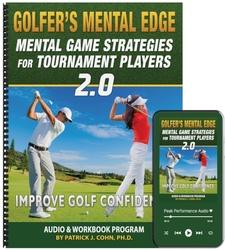
How to Cope With Negative Emotions
In golf, managing emotions is the game within the game.
You cannot play your best golf without managing your emotions.
Countless golfers have been thrown off their game due to runaway negative emotions.
For example, a stupid bogey stirs negative emotions in most golfers…
Follow that up with another bogey and intense frustration and anger may rise to the surface.
At that point, focusing is an even greater challenge and performance further deteriorates.
This starts a vicious cycle of intense negative emotions followed by poor play and the downward spiral swirls out of control.
Bad luck happens too…
An unlucky bounce or an unfavorable lie during a round can get your out of emotional balance.
That is to say, you need to maintain your composure when the unexpected happens.
Managing emotions is not an easy task as every golfer knows.
The reason for the extreme difficulty in managing emotions is two-fold:
- Most golfers do not know how to manage their emotions. Without effective tools and strategies, emotions are left to run amuck.
- Many golfers who may be aware of effective strategies to manage emotions have not sufficiently practiced these strategies so they can implement and rely on those techniques when needed.
It’s not just the intense, ultra-competitive golfers that have meltdown moments during a round of golf; mistakes, miss-reads and muffs can cause trouble for those golfers who are normally composed when playing.
One such golfer who is known for her composure is Brooke Henderson.
As stated earlier, runaway emotions can affect any golfer and it happened to Henderson at the 2018 KPMG Women’s PGA Championship.
Henderson was the co-leader after 36 holes but things unraveled for her during the last day of the tournament.
Interestingly enough, during the first round, Henderson was able to stay poised after a couple of bogeys but finished the day with a birdie on the 18th hole.
Henderson stumbled during the closing round making bogeys on three of her first six holes.
Frustration culminated on the 11th hole when Henderson slammed her wedge into her golf bag, snapping the club into two pieces after her wedge shot ran too far past the hole.
Henderson finished with a 74 to share 6th place.
In a bit of foreshadowing following the first round, Henderson talked about the snowball effect after a few mistakes on the golf course.
HENDERSON: “It’s kind of like when you’re hitting it really well, there’s no problem, but if you make one small mistake, I feel like they could cause a lot of mistakes really quickly.”
To sum up, frustration and anger can affect any golfer but, with the proper mental tools, you can effectively manage negative emotions and rebound by refocusing on what you need to do next.
Get Off the Bogey Train:
Don’t let one mistakes snowball into riding the bogey train….
You let go of mistakes by changing your reaction to them, your expectations about them, and thus your ability to move on…
Ask yourself: What’s so awful about mistakes?
Nothing except when you turn a mistake into more mistakes!
Learn all of our strategies for letting go of mistakes with “The Golfer’s Mental Edge”:
Related Golf Psychology Articles
- How to Deal With Negative Emotion
- Tips to Manage Emotions on the Golf Course
- How Scheffler Maintains Composure
- Subscribe to The Golf Psychology Podcast on iTunes
- Subscribe to The Golf Psychology Podcast on Spotify
Golfer’s Mental Edge 2.0

Do you suffer from fragile self-confidence after missed hitting shots or making mistakes, playing with strict or high expectations that undermine confidence, or the inability to play freely and relaxed on the course?
Successful golfers have learned how to perform with ultimate confidence in competition, so we’ve developed The Golfer’s Mental Edge 2.0 Workbook and Audio program to help you do this!
The Golfer’s Mental Edge 2.0 program includes the top 11 mental training sessions I do with my personal students to help them boost their mental game and improve consistency on the course!